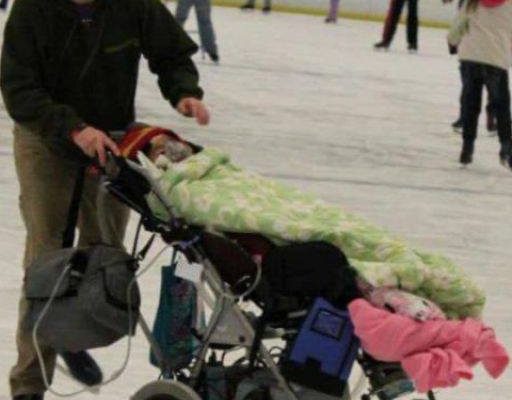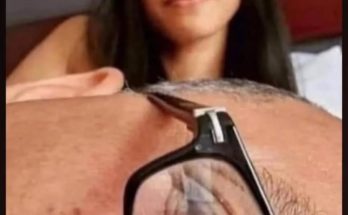She used to love watching the figure skaters on TV. Every winter, like clockwork, she’d point to the screen and say, “I wanna twirl like that, Daddy.” I’d just nod and say, “Someday.”
But the truth was—someday felt impossible.
Alina was born with a rare muscular condition. She’s seven now, still nonverbal, still in a medical stroller with a monitor humming at her side. We’ve had more hospital overnights than bedtime stories. Still, every time she saw a rink, her eyes would light up like it was Disney on ice.
So this year, I made a promise. Not a someday. A real one.
We bundled her in her coziest blankets, secured every tube and strap, and I wheeled her straight onto the ice.
People stared. Not in a bad way—just confused. Like maybe they thought we were lost or didn’t realize where we were. One teenager even offered to help carry her off.
But I told him, “We’re not leaving. We’re gliding.”
I shuffled my way forward, pushing her gently, one foot at a time. No grace, no speed. Just slow, careful movement. Her eyes stayed wide, and after a few laps, I noticed the tiniest smile peeking out from beneath the oxygen tube.
We passed a group of teens filming on their phones. One of them whispered, “That’s the most beautiful thing I’ve seen all day.”
But for me? It wasn’t even about beauty. It was about keeping a promise.
And then something happened I wasn’t ready for.
Her fingers—so small, so stiff—curled around mine. It was a fleeting touch, a gentle squeeze, but it sent a shockwave through me. A connection, a silent “thank you,” a moment that transcended words and limitations. Tears welled in my eyes, blurring the already slightly hazy rink lights. I squeezed her hand back, my heart overflowing.
We continued to glide, the rhythmic scraping of my skates the only sound besides Alina’s quiet, contented breaths. The initial stares from other skaters softened into smiles, nods of encouragement. One older woman, her face etched with a lifetime of stories, skated past and winked, mouthing, “Beautiful.”
That day at the rink wasn’t about defying Alina’s condition. It wasn’t about proving anything to anyone. It was about finding joy in the midst of challenges, about creating a memory, however small, that we could cherish. It was about showing my daughter that even if her body couldn’t twirl, her spirit could soar.
We went back to the rink every week that winter. Each time, Alina’s grip got a little stronger, her smiles a little wider. The other skaters started to recognize us, offering waves and words of support. The teenagers who had filmed us that first day even approached me, asking if they could share their video online to spread some positivity. I agreed, and the video went viral, touching hearts around the world.
The twist came a few months later. A renowned physiotherapist, who had seen the video, reached out to us. She had been working on a new therapy for children with rare muscular conditions, focusing on gentle, water-based exercises. She believed Alina might be a good candidate.
We were hesitant at first. We had tried countless therapies, each one promising miracles but delivering little. But there was something about the physiotherapist’s genuine enthusiasm and the promising early results of her research that gave us a sliver of hope.
We started the water therapy sessions, and slowly, miraculously, Alina started to respond. Tiny movements at first, a twitch of a finger, a slight bend of her knee. Then, over time, more significant progress. She started to babble, then whisper words. She learned to sit up on her own for short periods.
It wasn’t a cure, and she still faced significant challenges. But it was progress. Real, tangible progress. The ice rink, which had once seemed like a distant dream, had inadvertently opened a door to a possibility we had never dared to imagine.
Years passed. Alina, through sheer determination and the dedication of her therapists, learned to walk with the aid of braces. She still used her wheelchair, especially for longer distances, but she could take steps. She could even, with my help, stand on skates.
One winter, we returned to the same rink. Alina was ten now, a bright, articulate young girl with a mischievous glint in her eyes. The rink was still bustling, the music still echoing, but this time, Alina wasn’t in her wheelchair. She was standing at the edge of the ice, her braces gleaming under the rink lights, her hand clutching mine.
We took our first tentative steps together. She wobbled, her ankles shaky, but her smile was radiant. We moved slowly, just like that first day, but this time, she was an active participant. She pushed off with one foot, then the other, her laughter echoing through the rink.
We didn’t twirl like the skaters on TV. We didn’t glide with effortless grace. But we moved. Together. And in that moment, surrounded by the warmth of the community that had unknowingly cheered us on years ago, I knew we had come full circle.
The rewarding conclusion wasn’t just Alina taking those first steps on the ice. It was the journey, the unexpected turns, the kindness of strangers, and the unwavering power of a father’s love and a daughter’s spirit. It was about finding light in the darkest of times and realizing that even the most impossible dreams can sometimes, in the most unexpected ways, come true.
The life lesson here is that hope can be found in the most unlikely of places. Never underestimate the power of a simple act of love, a shared moment of joy, or the ripple effect of human kindness. And always, always keep your promises, even the ones that seem impossible. You never know where they might lead.
If this story warmed your heart, please share it and spread the message of hope and perseverance. And if you enjoyed reading it, give it a like. Your support is truly appreciated.



